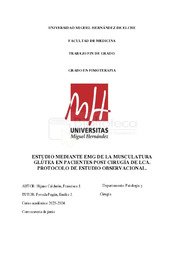Please use this identifier to cite or link to this item:
https://hdl.handle.net/11000/33590Full metadata record
| DC Field | Value | Language |
|---|---|---|
| dc.contributor.advisor | Poveda Pagán, Emilio José | - |
| dc.contributor.author | Hijano Calderón, Francisco J. | - |
| dc.contributor.other | Departamentos de la UMH::Patología y Cirugía | es_ES |
| dc.date.accessioned | 2024-10-22T09:26:10Z | - |
| dc.date.available | 2024-10-22T09:26:10Z | - |
| dc.date.created | 2024-06-01 | - |
| dc.identifier.uri | https://hdl.handle.net/11000/33590 | - |
| dc.description.abstract | Introducción: Las lesiones del ligamento cruzado anterior (LCA) son comunes en deportistas jóvenes, con entre 100,000 y 200,000 roturas al año. Son una de las lesiones más graves y costosas, con largos tiempos de recuperación. Las mujeres tienen mayor riesgo de lesiones de LCA debido a factores como su anatomía y fuerza muscular. La debilidad muscular, en particular en la cadera, aumenta el riesgo de lesiones de rodilla. La electromiografía de superficie (EMG) y la dinamometría manual son métodos efectivos para evaluar la activación y fuerza de esta musculatura. Objetivo: Evaluar la actividad y fuerza de la musculatura glútea (glúteo mayor y medio) de deportistas jóvenes que han sido intervenidos de cirugía de reconstrucción del LCA. Diseño: Estudio observacional de casos y controles. Material y método: una muestra de 50 sujetos dividida en dos grupos de igual tamaño: casos (intervenidos de cirugía de LCA) y controles (sin lesión de LCA) se someterán a un estudio para la medición de la musculatura glútea. El estudio se divide en dos sesiones: primera sesión en la que se familiarizaran con el ejercicio de peso muerto (DL) monopodal y realizaran un test de fuerza incremental (12RM) y segunda sesión, en la que se medirá mediante EMG de superficie la actividad de la musculatura glútea en las pruebas de DL monopodal y marcha en tapiz rodante. Discusión: Este protocolo de estudio pretende aportar información sobre el comportamiento de la musculatura glútea en pacientes intervenidos de LCA. | es_ES |
| dc.description.abstract | Background: Anterior cruciate ligament (ACL) injuries are common in young athletes, with a range between 100,000 and 200,000 tears per year. They are one of the most severe and costly injuries, with long recovery times. Women are at higher risk for ACL injuries due to factors such as their anatomy and muscle strength. Muscle weakness, particularly in the hip, increases the risk of injury in this region. Surface electromyography (EMG) and manual dynamometry are effective methods to evaluate the activation and strength of these muscles. Aim: To assess the activity and strength of the gluteal muscles (gluteus maximus and medius) of young athletes who have undergone ACL reconstruction surgery. Design: Observational case-control study. Materials and methods: A sample of 50 subjects divided in two different groups of equal size: cases (undergoing ACL surgery) and controls (without ACL injury) will undergo a study to measure their gluteal muscles. The study consists of two sessions: first session in which they will become familiar with the single-leg deadlift (DL) exercise and perform an incremental strength test (12RM) and second session, in which the activity of the gluteal muscles will be measured by surface EMG. in the single-leg DL and treadmill gait tests. Discussión: This study protocol aims to provide information on the activity of the gluteal muscles in patients undergoing ACL surgery. | es_ES |
| dc.format | application/pdf | es_ES |
| dc.format.extent | 44 | es_ES |
| dc.language.iso | spa | es_ES |
| dc.publisher | Universidad Miguel Hernández | es_ES |
| dc.rights | info:eu-repo/semantics/openAccess | es_ES |
| dc.rights | Attribution-NonCommercial-NoDerivatives 4.0 Internacional | * |
| dc.rights.uri | http://creativecommons.org/licenses/by-nc-nd/4.0/ | * |
| dc.subject | Lesión LCA | es_ES |
| dc.subject | Glúteo | es_ES |
| dc.subject | EMG | es_ES |
| dc.subject | Fuerza muscular | es_ES |
| dc.subject.other | CDU::6 - Ciencias aplicadas | es_ES |
| dc.title | Estudio mediante EMG de la musculatura glútea en pacientes post cirugía de LCA. Protocolo de estudio observacional | es_ES |
| dc.type | info:eu-repo/semantics/bachelorThesis | es_ES |

View/Open:
TFG HIJANO CALDERON FRANCISCO.pdf
1,44 MB
Adobe PDF
Share:
.png)
